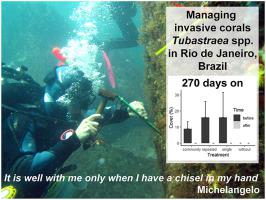Ocean & Coastal Management ( IF 4.8 ) Pub Date : 2021-03-18 , DOI: 10.1016/j.ocecoaman.2021.105616 Joel C. Creed , Fernanda A. Casares , Simone S. Oigman-Pszczol , Bruno P. Masi

|
Sun corals Tubastraea spp. from the Indo-Pacific have invaded hard grounds in the Caribbean, Gulf of Mexico, Brazil and Canary Islands where they cause significant ecological and economic damage to native systems, industry and society. In Brazil the National Plan for the Prevention, Control and Monitoring of the Sun Coral requires that sun corals are reduced to acceptable levels in nature and eradicated from vectors. Here we tested the efficiency of manual removal as a management tool at three sites along 260 km of Brazil's coastline with different oceanographic conditions (Ilha Grande, Rio de Janeiro and Cabo Frio). Four treatments were applied to shorelines undergoing management: (a) community removal (the whole benthic community scraped and stripped to bare rock), (b) sun coral single removal (c) sun coral repeated removal at 2 mo revisit) and (d) control areas naturally devoid of Tubastraea spp. Benthic communities were sampled over time using cover estimated from underwater photographs and larvae quantified in plankton trawls during management. The act of manual removal had no significant effect on sun coral larval abundance. The repeated removal method reduced cover at all sites to zero but a single removal was sufficient at sites with low densities of sun coral. The treatment effects varied systematically between sites, depending on local propagule pressure and invasion history. Manual removal is efficient and readily available and should be implemented in synergy with other methods to slow the spread of invaders, promote ecosystem recovery and allow time for the development of additional tools.
中文翻译:

多站点实验表明,通过人工清除来控制侵入性珊瑚(Tubastraea spp。)是有效的
太阳珊瑚Tubastraeaspp。来自印度洋和太平洋的海豹入侵了加勒比,墨西哥湾,巴西和加那利群岛的硬地,对当地的系统,工业和社会造成了严重的生态和经济损害。在巴西,《国家预防,控制和监测太阳珊瑚计划》要求将太阳珊瑚减少到自然界的可接受水平,并从媒介中根除。在这里,我们测试了在巴西海岸线260公里,三个海洋条件不同的三个地点(Ilha Grande,Rio de Janeiro和Cabo Frio)作为管理工具进行人工搬迁的效率。对进行管理的海岸线进行了四种处理:(a)清除社区(整个底栖社区被刮碎并剥去裸露的岩石),杜鹃花属(Tubastraea spp。)在管理期间,使用从水下照片中估计的覆盖物和在浮游生物拖网中量化的幼虫,对海底生物群落进行了长期采样。手动去除行为对太阳珊瑚幼虫的丰度没有显着影响。重复去除方法将所有位置的覆盖率降低到零,但是在太阳珊瑚密度低的位置进行一次去除就足够了。根据局部繁殖体的压力和侵袭史,治疗效果在部位之间系统地变化。手动清除是有效且容易获得的,应与其他方法协同实施,以减慢入侵者的传播,促进生态系统的恢复并留出时间来开发其他工具。









































 京公网安备 11010802027423号
京公网安备 11010802027423号